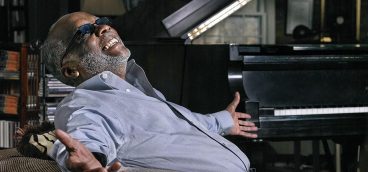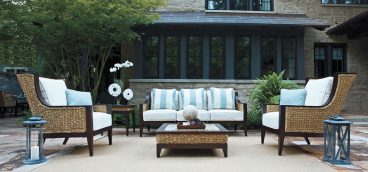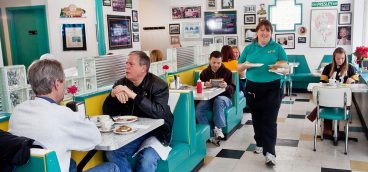On a painted mural behind the small stage of Pittsburgh’s newest jazz club, a singer in a dark red, strapless gown with a black bob hairdo sings to a sketched cityscape resembling Pittsburgh’s skyline at dusk. The real thing—Etta Cox—was there too, crooning standards “Teach Me Tonight” and “Misty” with the Harold Betters quartet, all before a packed and whooping house.
It was a superb opening Saturday for Little E’s at 949 Liberty Ave. in the Cultural District, a venue that owner George Kazas hopes will be the city’s first full-time jazz club since Dowe’s on 9th closed early in 2007. If the plan works, this club should help make Pittsburgh’s itinerant jazz scene a bit less so.
What used to be a community of clubs regularly hosting local performers has become a gypsy-like world in which fans drift from club to club with no regular jazz stage to call home. Many believe the beginning of that slide was the closing of the legendary Balcony, the Shadyside jazz club that closed in 1998 after 17 years of local and touring jazz acts. A CD of the last Balcony jam session features many jazz figures who remain acclaimed musicians in the city: Joe Negri, Kenny Blake, Gene Ludwig, David and Maureen Budway, Etta Cox and H.B. Bennett. Other familiar local jazz players, such as Betters, Dwayne Dolphin, Jimmy Ponder and Roger Humphries, maintain the distinguished tradition of Pittsburgh-bred jazz artists Ahmad Jamal, Billy Strayhorn, Eart “Fatha” Hines, Billy Eckstine, Kenny Clarke, Roy Eldridge, Mary Lou Williams, Stanley and Tommy Turrentine, George Benson, Ray Brown and Erroll Garner.
It’s true that the city’s jazz scene—like the nation’s—is not what it once was. The music, clubs and fans have changed and aged. But locally produced and packaged jazz can be found every night of the week in Pittsburgh. WDUQ-FM, one of few remaining full-time jazz stations in the nation, has extensive listings on its Web site.
Aside from Little E’s, there’s the South Side’s Gypsy Café. This well-named club is a small eatery in a former church on Bingham Street, just off Carson Street. The place conjures memories of Rick’s Café in “Casablanca.” Along the walls of the spacious room, religious icons fill one corner, modernistic paintings and renderings another, a set of hanging hand and wall mirrors yet another. It is an eclectic décor, like the crowd, which on one recent night consisted of graying aficionados, a scattering of middle-aged professionals, and an entourage of young musicians, all listening to the Don Aliquo trio.
Martini’s in Clairton is the semi-regular jazz nest of Spider Rondinelli. Here, jazz is served up Fridays and Saturdays along with food and drink in a cramped but rousing setting beneath photos of jazz musicians hanging on the wall and big-screen televisions beaming sports to a barroom filled to capacity.
Over in Oakland, the Holiday Inn stages a relaxing end-of-weekend selection of live jazz, suitably soothing for a Sunday evening. Surrounded by café-style tables, musicians take the floor in front of black-and-white murals depicting urban scenes. At stage left, a wooden-slatted window looks out onto a cool atrium.
To find the younger jazz guard in Pittsburgh, try the Ava Lounge in East Liberty on a Monday night, for what may well be one of the hottest music jams in the city. The place is a work in progress, a former business office with the dropped ceiling lifted to reveal a soaring black tin-type surface with an arched skylight above the stage. But the real progress in this fine listening room—long and narrow, with built-in couches and café seating served by coffee and side tables, all done up in black and silver—is the progressive jazz blowing from the Howie Alexander Trio. This is a class act that bodes well for the city’s jazz future.
At C.J.’s in the Strip District, the Kevin Howard Band may be found on the parquet stage on Saturday nights, blowing a funky, electric sound that mixes smooth jazz with a rhythm-and-blues-tinged strut. This quartet includes musicians in their 30s and 40s who are largely self-taught, though two of them—electric keyboardist Howard and saxman Walt Lowry—were mentored by Carl Arter, a pianist/saxophonist who influenced many Pittsburgh musicians, including Stanley Turrentine. Think supper club. Here, folks sit at the bar munching on chicken while the band fills the place with amplified music. Jazz-themed art adorns the white walls, punctuated by black ceilings and black trim in art-deco mood.
Meanwhile, downtown, the folks at the Backstage Bar in Theater Square in the Cultural District do rush hour right on Tuesday nights. While cars and buses stack up at red lights and on-ramps, Downtowners relax on the square, or inside this Manhattan-style bistro, along with a small ensemble of local jazz musicians.
There’s more, including Roger-Humphries-hosted jams at C.J.’s on Thursday nights; Kenny-Blake-led sessions at Gullifty’s in Squirrel Hill on Wednesdays; Sunday night gatherings hosted by WDUQ jazz DJ Tony Mowod and the Pittsburgh Jazz Society at the Rhythm House in Bridgeville; and regular touring acts appearing at the fine listening room of the Manchester Craftsmen’s Guild.
All are part of a jazz climate that, while rarer, more spread out and sporadic, is no less cool, or hot, than that of the legendary days of yore. Just check the DUQ listings for a gig, not necessarily near you, but always out there in the night (and some afternoons), somewhere.





